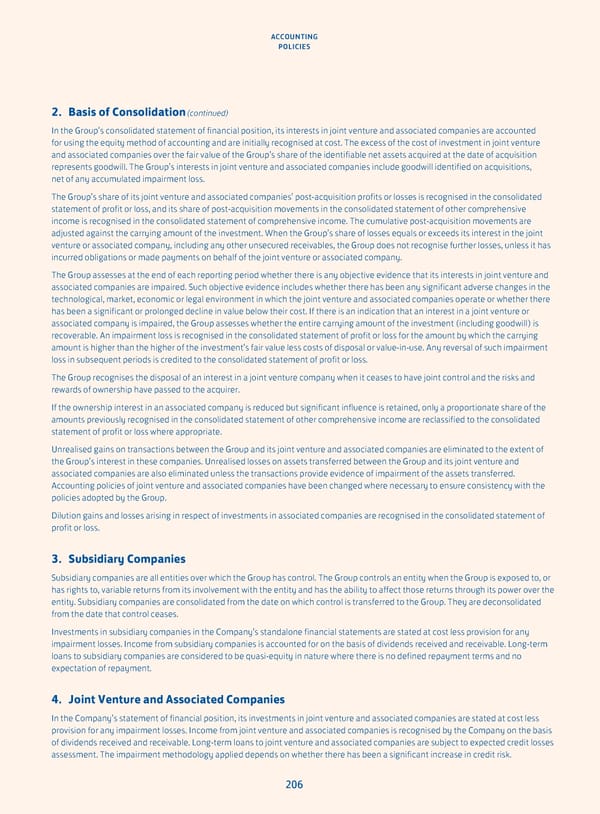ACCOUNTING POLICIES 2. Basis of Consolidation (continued) In the Group’s consolidated statement of financial position, its interests in joint venture and associated companies are accounted for using the equity method of accounting and are initially recognised at cost. The excess of the cost of investment in joint venture and associated companies over the fair value of the Group’s share of the identifiable net assets acquired at the date of acquisition represents goodwill. The Group’s interests in joint venture and associated companies include goodwill identified on acquisitions, net of any accumulated impairment loss. The Group’s share of its joint venture and associated companies’ post-acquisition profits or losses is recognised in the consolidated statement of profit or loss, and its share of post-acquisition movements in the consolidated statement of other comprehensive income is recognised in the consolidated statement of comprehensive income. The cumulative post-acquisition movements are adjusted against the carrying amount of the investment. When the Group’s share of losses equals or exceeds its interest in the joint venture or associated company, including any other unsecured receivables, the Group does not recognise further losses, unless it has incurred obligations or made payments on behalf of the joint venture or associated company. The Group assesses at the end of each reporting period whether there is any objective evidence that its interests in joint venture and associated companies are impaired. Such objective evidence includes whether there has been any significant adverse changes in the technological, market, economic or legal environment in which the joint venture and associated companies operate or whether there has been a significant or prolonged decline in value below their cost. If there is an indication that an interest in a joint venture or associated company is impaired, the Group assesses whether the entire carrying amount of the investment (including goodwill) is recoverable. An impairment loss is recognised in the consolidated statement of profit or loss for the amount by which the carrying amount is higher than the higher of the investment’s fair value less costs of disposal or value-in-use. Any reversal of such impairment loss in subsequent periods is credited to the consolidated statement of profit or loss. The Group recognises the disposal of an interest in a joint venture company when it ceases to have joint control and the risks and rewards of ownership have passed to the acquirer. If the ownership interest in an associated company is reduced but significant influence is retained, only a proportionate share of the amounts previously recognised in the consolidated statement of other comprehensive income are reclassified to the consolidated statement of profit or loss where appropriate. Unrealised gains on transactions between the Group and its joint venture and associated companies are eliminated to the extent of the Group’s interest in these companies. Unrealised losses on assets transferred between the Group and its joint venture and associated companies are also eliminated unless the transactions provide evidence of impairment of the assets transferred. Accounting policies of joint venture and associated companies have been changed where necessary to ensure consistency with the policies adopted by the Group. Dilution gains and losses arising in respect of investments in associated companies are recognised in the consolidated statement of profit or loss. 3. Subsidiary Companies Subsidiary companies are all entities over which the Group has control. The Group controls an entity when the Group is exposed to, or has rights to, variable returns from its involvement with the entity and has the ability to affect those returns through its power over the entity. Subsidiary companies are consolidated from the date on which control is transferred to the Group. They are deconsolidated from the date that control ceases. Investments in subsidiary companies in the Company’s standalone financial statements are stated at cost less provision for any impairment losses. Income from subsidiary companies is accounted for on the basis of dividends received and receivable. Long-term loans to subsidiary companies are considered to be quasi-equity in nature where there is no defined repayment terms and no expectation of repayment. 4. Joint Venture and Associated Companies In the Company’s statement of financial position, its investments in joint venture and associated companies are stated at cost less provision for any impairment losses. Income from joint venture and associated companies is recognised by the Company on the basis of dividends received and receivable. Long-term loans to joint venture and associated companies are subject to expected credit losses assessment. The impairment methodology applied depends on whether there has been a significant increase in credit risk. 206
 Annual Report 2023 Page 207 Page 209
Annual Report 2023 Page 207 Page 209